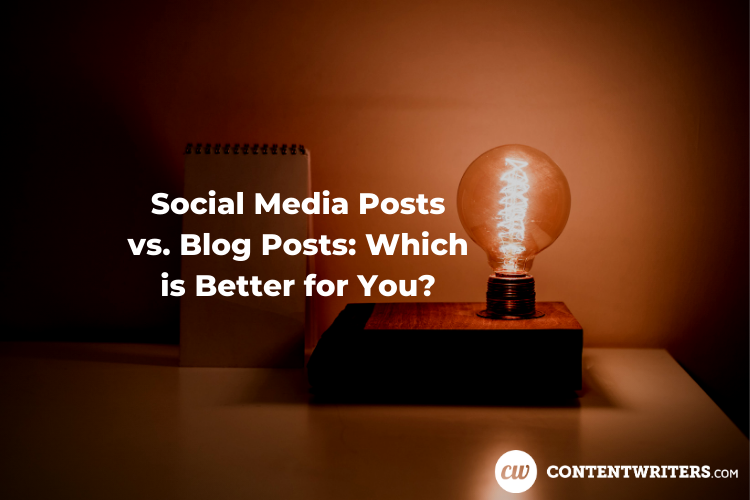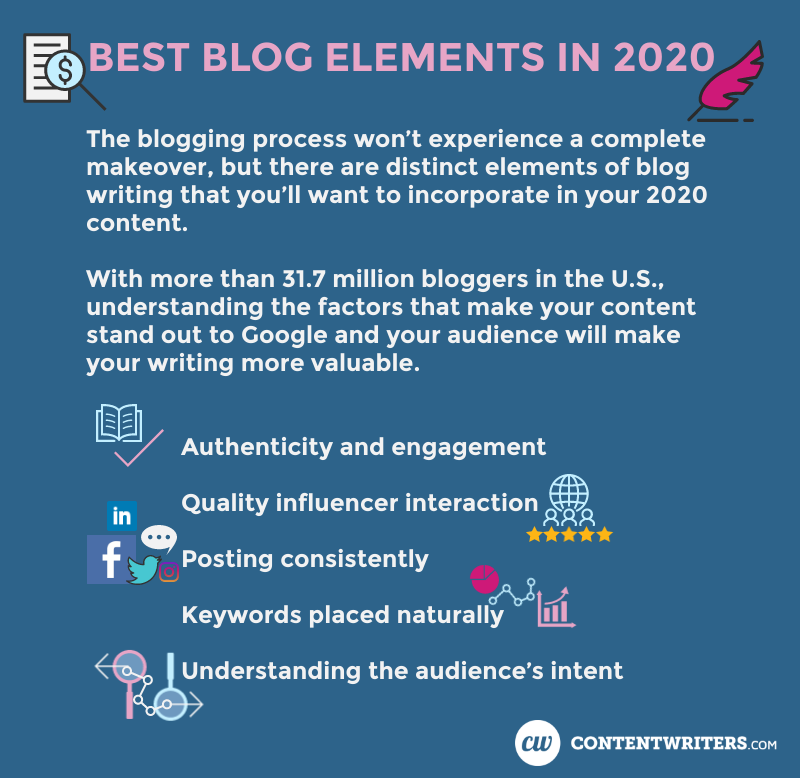
Social Media Posts vs. Blog Posts: Which is Better for You?
When you’re developing digital marketing content, there are two primary types of copy that nearly every company needs: social media posts and blog posts.
If you’re concerned with which one is better for your business, here is some information to consider. For most companies, the focus should be a combination of both.
What Is a Blog Post?
A blog post is an article that is posted on a periodically updated web page commonly called a blog. Blogs are used as a means of drawing traffic to websites because of continuously updated, relevant, and interesting content.
In many ways, it is similar to a newspaper where new content is made available on a daily or weekly basis. Blog posts are generally 500 words in length, although they can stretch up to 2,000 words based on the topic and format.
Many blog posts include pictures, keywords, links to other posts or products, and may include advertising to drive online sales.
What Are Social Media Posts?
Social media posts are any type of post that is added to a channel on a social media platform. The form of the post is determined by the platform. For example, Twitter posts can only have up to 280 characters per post, while Facebook does not have a limit on post length.
Instagram specializes in picture posts, while others, like Youtube, only allow video content. Many platforms allow multimedia content options, but every platform has its own restrictions.
The goal of social media posts is to attract the attention of people that are interested in the topic of the post and link them to your website. Many businesses and individuals focus on a specific set of topics in an effort to cultivate a publication to a particular audience. By doing so, they gain influence and can drive sales and engagement.
Benefits of Blog Posts

Blog posts are a common choice for websites for several reasons. Because blogs are regularly updated, they make websites more relevant to search engines. Search engines regularly scan web pages that have already been indexed looking for new content. Active sites that receive regular updates are considered more important than static websites, so they rank higher in SEO assessments. Businesses use this method to keep their websites high in the SEO ranking.
Businesses also use blog posts to add updated information to their websites. It is an effective method of educating customers, building an audience of interested customers, and driving sales of products and services. The more a company can educate customers about its products and specialized services, the more they will be motivated to buy from them.
Unlike social media posts, blog posts provide longer-lasting content for websites. Social media posts are often situational and event-driven, so the content becomes irrelevant quickly. Blog posts are self-contained experiences and can continue to be relevant as long as the topic of the post is still relevant. Many companies rely on this fact to develop a lasting online presence by providing self-contained experiences around a central theme. Therefore, it becomes a lasting resource for customers to learn about a specific topic.
Blog posts are also preferred because they are generally longer, making it possible to provide more content to explain a point. Many topics require long-form explanations and detailed analyses to be useful. Blog posts make it possible to explain everything about a topic in a single post which makes them more useful and a complete resource for readers.

Disadvantages of Blog Posts
While blog posts are the standard option, there is one clear disadvantage – blog posts take time and resources to create. Some require extensive research to write authoritatively. This means it will take more resources to create a single blog post than to make numerous social media posts.
Limitations of Blog Posts
Blog posts have several limitations, as well. A blog post is most effective when there is an existing audience. Building an audience for a blog takes time and careful cultivation. Once the audience is established, posts become more effective. However, it is more difficult to get a blog post in front of a viewer than a social media post seen by the same person.
Blog posts are also limited to search engine distribution and visibility. Social media platforms have their own distribution networks, while blogs generally do not. They rely on search engines to draw in viewers.

Benefits of Social Media Posts
Social media posts are a preferred marketing method because they are easier to produce and have a chance of reaching a massive audience. Social media posts are generally made with short-form content. This makes them faster and easier to produce. These posts are also easier to consume so viewers prefer them for quicker, more interesting content. The right post could go viral or spread around wide social circles quickly. A viral post reaches a wider audience with more social impact and credibility resulting in a higher ROI. Social media posts are also used in paid ads, making them easy to place.
Disadvantages of Social Media Posts
The biggest downside to social media posts is that they stay around long. There are millions of posts each day globally and they offer little in long-term content relevance. Everyone moves on to the next thing quickly giving social media posts a short lifespan. This makes it more difficult to drive sales or engagement since viewers leave the posts so quickly.
Limitations of Social Media Posts
Another limitation of social media posts is that they are entirely reliant on their social media platforms for distribution. Search engines have a hard time indexing social media posts, so there is very little cross-platform audience engagement because search engines cannot promote posts outside of their respective platforms. This means companies need a separate online presence on each of the social media platforms that they want to use.
Products vs. Services
Whether a company should prioritize social media over blog posts could depend on what it sells. For a product-based company, social media could be a more important tool used to demonstrate the product in a visual way to an audience that might not otherwise know about it. For instance, using social media to show off a pet paint to new customers who can then share the innovative and fun idea with their friends. Everyday people scroll through their social media feeds and “Like” or “Follow” the brand because it’s interesting to them. After all, most products can be shipped anywhere a customer lives.
For service companies, this can sometimes be more difficult. For example, a plumbing company is localized. Most Facebook users aren’t going out of their way to find and like the social media posts of every plumbing company that uses Facebook, especially if it’s out of their service area. Blog posts with SEO content about common plumbing issues and geotags about the relevant service area would be more searchable as a blog post.
B2B vs. B2C
With B2B companies, the focus on social media needs to be more nuanced. Most of the social media users available aren’t the decision-makers at a company. If you invest heavily in a social media advertising campaign for a B2B business, you may end up wasting a lot of money on an ineffective campaign that doesn’t reach decision-makers. LinkedIn is a good platform for social media posts and can be more beneficial to B2B businesses. This is an effective platform for companies who want to position themselves as thought leaders among their peers. This strategy may or may not directly impact sales.
For B2C companies, social media can be a really effective way to get a new product in front of customers. Social media networks, such as Facebook and Twitter, are full of consumers. Even the decision-makers at companies become consumers on social media networks.
Best Plan to Utilize Both
For most companies, it is a good idea to utilize both social media posts and blog posts in a well-rounded content marketing plan. Creating high-quality blog posts to be distributed on your company’s website can position your company as an industry leader and help to connect with new customers. You can write blog posts that can be shared through social media networks to push more original content on social media in a way that benefits both.
If your company wants to drive traffic and engagement online, then a combination of blog posts and social media posts is likely your best option. By combining systems, you can expand your audience and supplement long-form content with short-term bursts of engagement. Whichever method you choose, you will need to know everything about the different methods. Check out the biggest influencers in your field to see what they are doing and how you can leverage those techniques for yourself.
Melanie G. is a freelance writer and editor living in Tampa, Florida. She’s freelanced full-time since she left her writing job at Nielsen in 2012.





